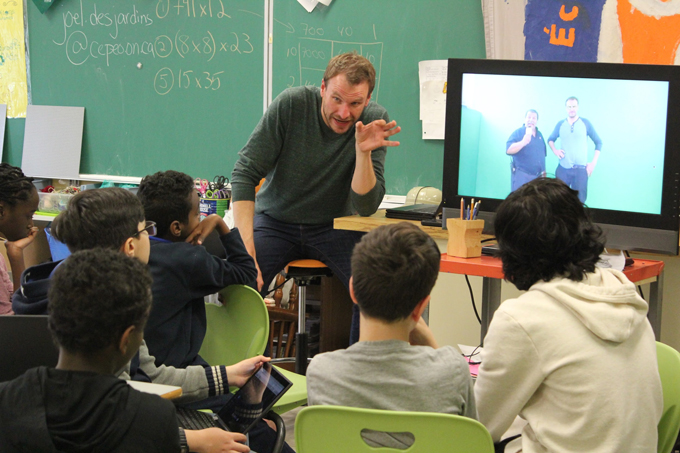
Joël Desjardin’s decision to become an elementary teacher was driven in part by his personal belief that to thrive in school and in life, many children need learning conditions broader than those offered by traditional paradigms. As we talked about the impact of the makerspace that he has worked tirelessly to establish over the past two years with colleagues, his voice resonated with passion and a deep respect for his students and their learning needs.
“The makerspace is the heart of our school. When I was a kid, the gym was the heart of community in the school. Whenever there was a big event, we all gathered in the gym. But I see the makerspace as our ‘gym.’ Our whole community can’t gather here physically but we do use technologies in the makerspace to create community, to bring us all together—through our TéléMC newscasts, for example. And, the comings and goings in this space are incredible,” he said. “The kid who comes in here and finds that he can make something driven by his own interests—he’ll keep coming back to school. That’s what will keep him here.”
In the makerspace, Joël’s mission is to create the conditions and cultivate the relationships that will enable every child to find their voice, strengths, and purpose. More than 60% of students attending this school have lived in Canada for fewer than three years, and many do not speak French (the language of instruction) at home. In Joël’s words, “We’re imposing Canadian culture and language on these kids, and then we’re imposing Canadian schooling on top of that—they need to have spaces inside of these systems where they can leverage what they know, where they feel competent, capable, and valued.”
As they work to support students’ language and literacies learning, Joël and his colleagues understand that their work is also fundamentally about creating an inclusive community where students can find connections to themselves as they develop new identities as learners, as makers, and often, as first-generation Canadians. I think the work happening in this school can inform the design of culturally sensitive, social justice-oriented maker pedagogies for literacies learning everywhere. Following are two examples that could inspire other school communities to imagine new possibilities for their maker programs.
Café Altern
This spring, sixth-grade students from Joël’s school visited Café Altern, a coffee shop in Ottawa’s Byward market, run entirely by high school students and their teachers. For Joël’s students, the purpose was twofold. First, he wanted to expose them to the program which is designed for high schoolers seeking pathways to employment through entrepreneurship. Second, he wanted his students to practice their media literacies skills. To this end, groups of students planned for, and then interviewed a Rwandan–Canadian artist whose work is exhibited in the Café, a local chef who supports the café, and the teachers and students who run daily operations.
Using the industrial kitchen, the sixth graders also learned to make, prepare, and then sell maple syrup that they had tapped from trees at school (using spiles that they 3D printed in the makerspace). Post visit, the students used 10 hours of class time to edit their footage in WeVideo and create two-minute videos promoting the café. In my view, this activity integrates layers of culturally situated, physical, and digital meaning making, centered on community partnerships and student agency.
TéléMC
With a team of student media makers, Joël also produces the morning announcements which they livestream on the school’s YouTube channel from their makerspace every morning. For these students, Joël cites vast improvement in confidence and oral communication skills. Every Friday, the team produces a longer newscast that includes highlights of the week and explores an important theme.
Last week, on the International Day Against Homophobia, Transphobia, and Biphobia, their newscast focused on equipping the school community to understand what it means to be LGBTQ2+, to recognize and reject LGBTQ2+phobic language and behaviors, and to emphasize the importance of LGBTQ2+ people in their school community. Especially poignant—the principal, who cohosted this special newscast, drew a picture of his own family, showed photographs of his family celebrating important moments together, and explained that his children have two dads. With more than 250 views for this newscast alone, the work in this makerspace is reaching community beyond the school walls, and equipping students and faculty to understand and use a shared language of inclusion.
As Joël, his colleagues, and his students show us, a school makerspace can become its heart—a place where technologies can be used to make meanings that strengthen, empower, and create more inclusive communities.
Michelle Schira Hagerman is an assistant professor of Educational Technologies at the Faculty of Education, University of Ottawa. You can read more about her work, including research on literacies and making at mschirahagerman.com